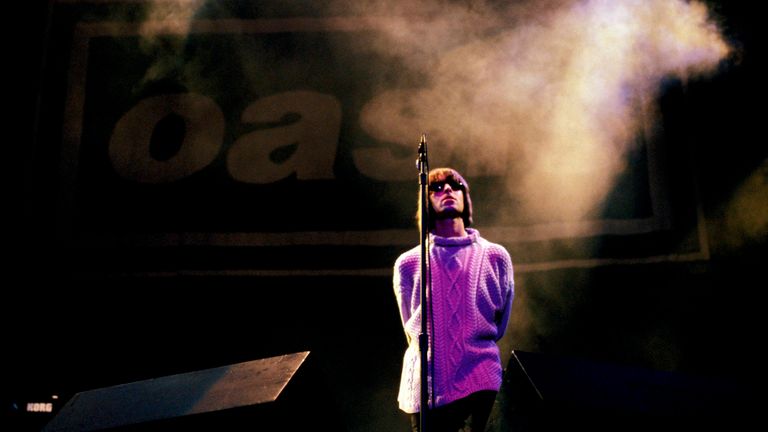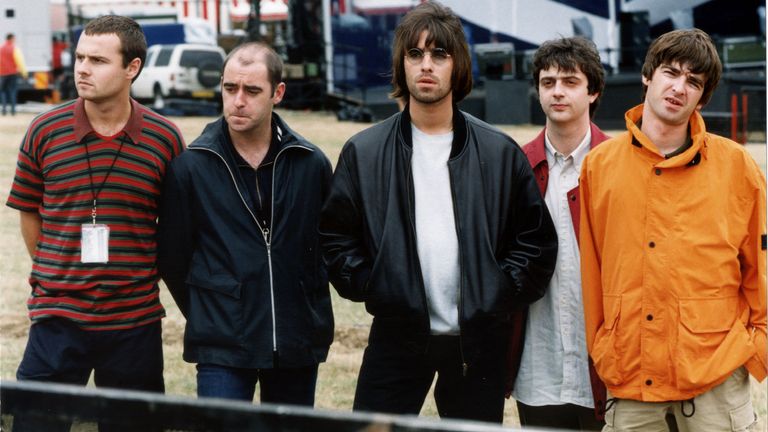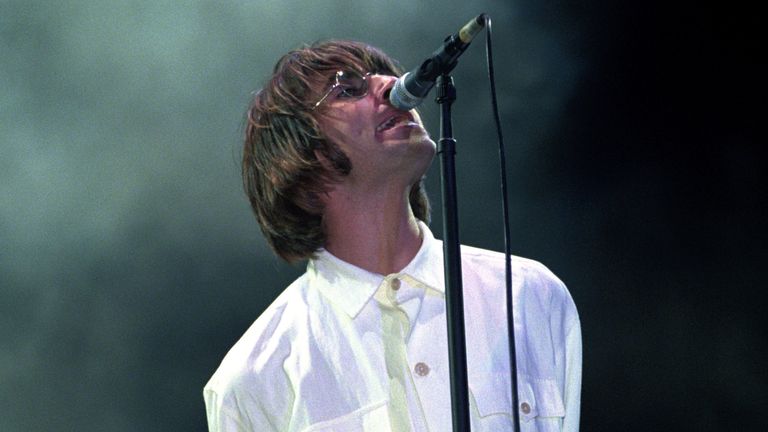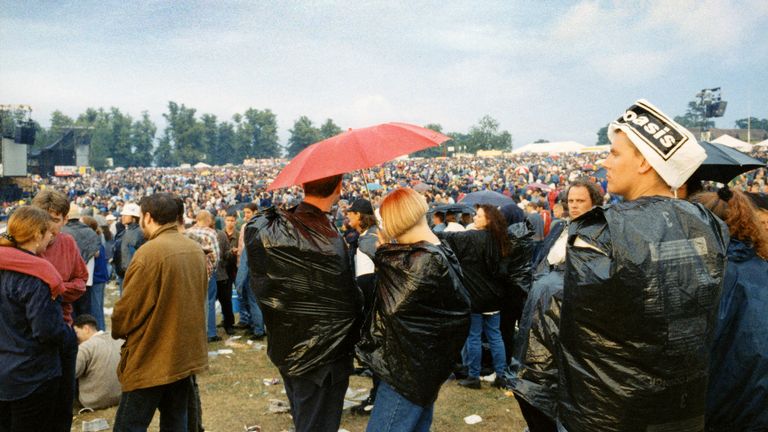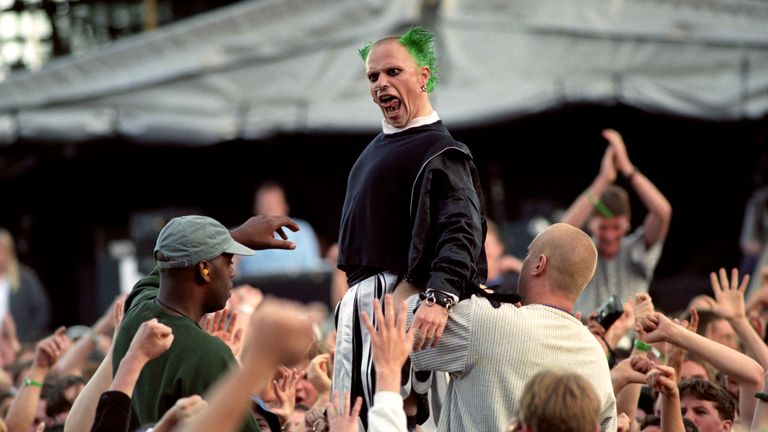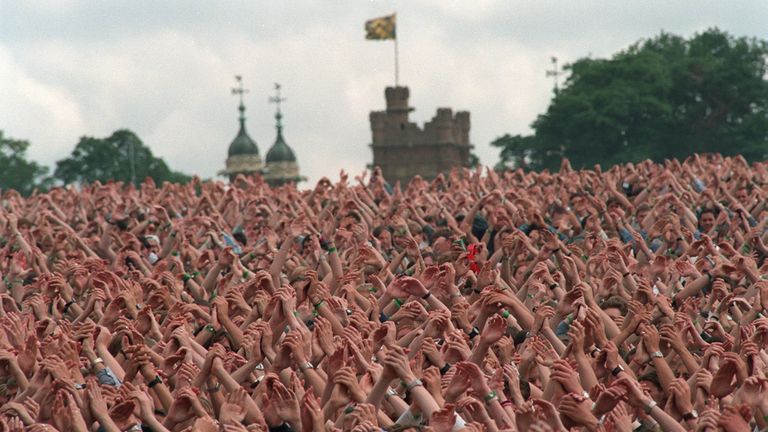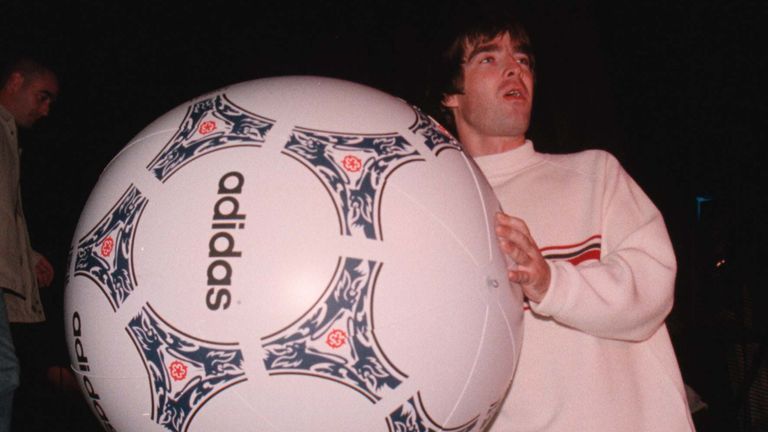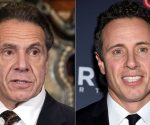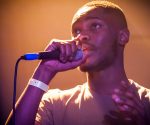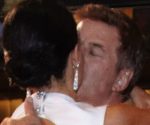Oasis Knebworth 1996: Looking back at Liam and Noel Gallagher’s historic shows after 25 years | Ents & Arts News
[ad_1]
It was perhaps the most audacious event in British music history: two gigs, 250,000 people, from a band just shy of marking two years since the release of their debut album.
In that time, Oasis had pretty much bypassed mid-size venues, progressing from small clubs straight to stadiums, to hosting Britpop’s biggest party at a stately home in Hertfordshire. “This is history,” Noel Gallagher famously told the Knebworth crowd. “Right here, right now, this is history.”
The tickets were £22.50 and the line-up included The Prodigy, Manic Street Preachers, The Chemical Brothers and The Charlatans, depending on which night you were there. An estimated 2.5 million-plus people applied to go, breaking box office records, and the stories from the shows are the stuff of music legend: the helicopter arrival, Liam Gallagher‘s golf buggy joyride, the celebs mingling backstage; Mick Hucknall, for some reason, the one that everyone seems to have a tale about.
But the real story of that weekend is that of the band’s unique relationship with the fans, says Jake Scott, director of the Oasis Knebworth 1996 documentary. Interspersed with footage from the two gigs, the programme places the fans back as if they were there, with nostalgic dramatisations taking the viewer back to the ’90s, the excitement building on car trips, the queuing to get as near to the stage as possible, the buzz of finally of getting through to buy tickets on the landline.
“Everyone wanted to be there,” Scott tells Sky News. “It was already famous before it happened, the biggest rock concert on British soil in history.
“The contact between the band and the crowd, I think, is palpable. It’s a tangible thing. And for a lot of those people who went, it was maybe their first gig ever. There’s a lot of stories. And those anthems really resonated with that audience because it sounded like them.”
For Scott, who first met the band when he directed the video for Morning Glory in 1995, it was a chance to revisit the gig he missed out on.
“I had a ticket, I couldn’t go,” he says. “I was abroad, working. All my mates went and I’m still gutted now, especially doing the film, I realised really what I’d missed. I suffered what we now call FOMO (fear of missing out), majorly.” Fortunately, he says, the footage from the event “really gets under the skin of it”.
Michael Spencer Jones, a photographer behind Oasis’s albums and singles covers during that period, says that after first seeing the band play to just a handful of people less than three years earlier, it was a momentous weekend for those who had been with them since the beginning.
“You spend all this time with a band and you get to know them… there’s huge emotional investment in the music and what it means to everyone. So being in the crowd and thinking, ‘wow, they’ve gone from playing in front of, like, 12 people to this in just over two-and-a-half years’. It was astonishing, that journey from humble beginnings to the whole country being completely captivated.”
Scott’s documentary is an unapologetic celebration of the band in its heyday and of the 1990s, setting the gigs up against the backdrop of Euro ’96, the explosion in the art scene at the time, and “this bloke Tony Blair who was going to change everything”. It also highlights how different things were at gigs before camera phones came into play.
Even Spencer Jones, off-duty for Knebworth, has only two quickly snapped pictures from the weekend, one of the fans and another of the clean-up. “I think Noel once said that the only problem with being in Oasis was that he never got to see them,” he says. “So it was nice, not having the responsibility of taking any photographs and just being able to watch.”
Many who were there – including Liam and Noel – have said they don’t remember a lot of it. Not necessarily because of alcohol or drugs – “speculation about anyone being drunk or high on stage or anything like that is quickly dismissed [when you see the footage] because you can’t be that good, for two nights and sustain it like that, and be out of it, it’s just not possible”, says Scott – but perhaps the intensity of the occasion.
“I watched both nights from the stage, so I had the best view in the house,” says Brian Cannon, the band’s artwork designer at the time. “But I don’t remember a single second of either gig – not because I was hammered, because I wasn’t. I remember vividly other bits of the event, but the actual gig itself, I genuinely can’t remember a single thing about it, which, funnily enough, is what both Liam and Noel say. It’s like it was almost… it was just so intense, it just wiped itself from my memory.”
What Cannon recalls most is “the insane size” of the event. The backstage guestlist, for about 7,000 people, was in itself bigger than most gigs. “I remember thinking I’m glad I’m not a punter out the front there because I couldn’t imagine using a toilet or getting a drink or food or anything, it was just immense,” says Cannon. “That was the overarching memory for me.”
The documentary features some emotional fan accounts of the weekend – the guy who found out just before that he was to become a father, another who ended up with Liam Gallagher’s tambourine as a souvenir, and the particularly poignant story of the girl who attended with her brother, not knowing he would soon be diagnosed with cancer and this would be one of her last memories of the pair together “just enjoying life”. There is also an anecdote from the fan who ended up being invited into a limo to give directions to a driver transporting Kate Moss and Anna Friel.
As well as those stories, the programme highlights the relationship between Noel and Liam at the time, before things turned acrimonious.
“You’re only as good as your frontman, any band, and if that is Oasis at its peak – which it is – it’s because Liam’s at his peak,” says Noel in the documentary, his younger brother’s distinctive, snarling live Slideaway playing in the background, demonstrating his point.
“A big part of telling the story was showing that camaraderie and brotherhood,” says Scott. “They’re two brothers, with their best mates… the meteoric trajectory of [playing Knebworth] and they’re having a laugh and mucking about it, really enjoying themselves. I love seeing that relationship, the spontaneity of it, I think it’s a lot of fun to watch. There’s a sweetness in it and something very emotional about it.
“The other thing I think is remarkable is they don’t seem nervous, just totally taking it in their stride. It’s almost like you can see the evident enjoyment of being there and wanting it to be great.”
Both Noel and Liam Gallagher serve as executive producers and you hear from them in the documentary; Noel far more so than Liam, who only comes in at the end to say how watching the film “brought it all back”, and that the gigs were “biblical”. Scott says he believes Liam’s feeling was that the programme speaks for itself and that he is concentrating on his solo career, although it’s hard to imagine this wouldn’t have been different had the brothers been on speaking terms.
One thing the Gallaghers didn’t want to include was the band’s rivalry with Blur at the time, says Scott. “There were some things we took out… they didn’t want to continue this idea that there was this animosity between them and Blur, for instance, [because] those days are gone.”
So the documentary is all about the good times. Both Spencer Jones and Cannon say that even at the gigs, there was a sense that things couldn’t get any bigger than Knebworth.
The band were getting “harder and harder to be around”, says Spencer Jones, purely because of the level of fame they had reached and the growing amount of people working around them. And the cracks in the brothers’ relationship were there. “When they were together, they were very funny and witty,” he says. “It was incredibly entertaining to watch… They were close. But there was always that frisson between them.
“I think Liam described it perfectly. He said, ‘if we had a fruit and veg store, we’d argue about where to put the tomatoes’, and I think that really summed up their relationship. There was a serious fault line. The irony is that it created that creative relationship, the very thing that ultimately drove them apart was the very thing that made that relationship special.”
“Where do you go from that?” says Cannon, of the Knebworth shows. “It couldn’t really get any bigger. I mean, they carried on in terms of excess because they recorded Be Here Now, a Rolls Royce in a swimming pool on the cover. The excess continued, just not in terms of big gigs.”
Not of Knebworth size, at least. The band continued to fill arenas until Noel eventually called it a day in 2009. He has made it clear he has no plans for a reunion. But could the documentary maybe have stirred something inside him?
“I don’t have the answer to that,” says Scott. “I hope so. We all want to see that, I’d love to believe that could happen.” He pauses. “You do feel like this one’s possible though, don’t you?”
Oasis Knebworth 1996 is in cinemas from 23 September
[ad_2]
Source link






